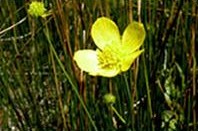Fall buttercup facts for kids
Quick facts for kids Fall buttercup |
|
|---|---|
 |
|
| Conservation status | |
| Scientific classification | |
| Genus: |
Ranunculus
|
| Species: |
aestivalis
|
Ranunculus aestivalis is a very rare type of buttercup. It is also known as the fall buttercup or autumn buttercup. This special plant only grows in Utah, in a place called Garfield County. It lives in wet, marshy spots near the Sevier River. These wet areas are very small and surrounded by dry land. Because it is so rare, the United States government lists it as an endangered species. People have called it one of the most beautiful buttercups in the western United States. They also say it is one of Utah's rarest plants.
Scientists sometimes thought this plant was just a type of Ranunculus acriformis or Ranunculus acris. But in 1994, a genetic study showed it was different enough. So, it was given its own species name.
Contents
What the Autumn Buttercup Looks Like
This plant has a stem that stands straight up. It can grow to be about 30 to 60 centimeters (about 1 to 2 feet) tall. The stem is also a bit hairy. Its leaves are usually divided into three parts. Sometimes, they look like three separate small leaves.
Each autumn buttercup plant grows about 6 to 10 flowers. Each flower has five, or sometimes ten, bright yellow petals. These petals are about one centimeter long. The plant blooms from July all the way through October. This is why it is called the fall or autumn buttercup. Its scientific name, aestivalis, comes from a Latin word meaning "about summer."
Where the Autumn Buttercup Lives
The autumn buttercup grows in wet, riparian meadows. These meadows are on the western side of the Sevier River Valley in Utah. Springs feed these meadows, which keeps them very wet and marshy. The plants often grow on slightly raised areas within these boggy meadows. They can also be found in drier spots nearby.
Many other plants share this special habitat. Some of these include Achillea millefolium, Juncus articus, Carex nebrascensis, and Symphyotrichum spathulatum. You might also see Plantago eriopoda, Glaux maritima, and Carex aquatilis. Other plants like Hordeum jubatum, Trifolium, Dodecatheon, and Eleocharis species grow there too. Small Mosses also grow among these plants.
Why the Autumn Buttercup is in Danger
The autumn buttercup needs a very specific amount of water to survive. Changes in the local hydrology (how water moves in an area) are a big threat. For example, too much or too little water from Irrigation can harm the plants.
Grazing by animals can also affect the plant. Sometimes, grazing can be helpful. Livestock might eat other plants that compete with the buttercup for space and sunlight. But too much grazing can also damage the buttercups. Because there are so few plants left, they might also face a genetic bottleneck. This means they have less variety in their genes, which can make them weaker.
Helping the Autumn Buttercup
People thought this plant was completely gone in the 1970s. But then, it was found again in 1982! The Nature Conservancy, a group that protects nature, bought the land where the buttercups grow. They turned it into a nature preserve.
Scientists also learned how to grow the plant in a lab using tissue culture. The Nature Conservancy and other groups have planted more autumn buttercup plants in the preserve. This helps to make the small population of these rare flowers a bit bigger.
See also
In Spanish: Ranunculus aestivalis para niños


